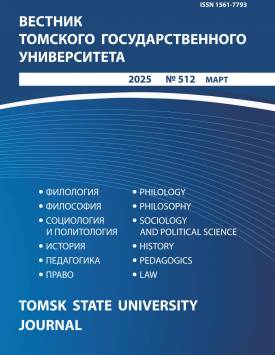Core animalistic images in comparative phraseology
The aim of this article is to analyze comparative phraseological units and compare the core animalistic images of English, German, Russian, and Chinese linguacultures found in these units. The relevance of the article is due to the linguocultural analysis of the stable comparatives and the addition of Chinese to the Indo-European languages as the research material. The comparative phraseological units were divided into thematic groups: (1) wild animals, (2) domestic animals, (3) birds, (3) fish, mollusks, amphibians, and reptiles, and (4) insects. The total number of comparatives amounted to 517 units. Having studied the national, cultural specificity, semantic features of phraseological units with zoonyms, ornithonyms and insectonyms, as well as having analyzed examples of their use in the corpora of the languages under study, the authors of the article identify the universal core images for all the languages under consideration and partially coinciding core images. Special attention in the article is paid to the core images which are specific for this or that linguaculture. The authors infer that the differences at the level of connotative evaluation are explained by the different content of the images in the analyzed linguacultures. The reference image is formed by basic ideas about the appearance and habitat of a particular animal, and in the case of Chinese, also by the characteristics of special zooanthropomorphic creatures that have the features of this animal and are mentioned in myths and works of classical literature. Consequently, unlike Western linguacultures, in the Chinese one the core image can be multidimensional and ambivalent. Based on the comparison, the authors conclude that the national identity of linguacultures is expressed through the system of evaluative core images. Studying and comparing these images, we can acquire information not only about the aesthetic perceptions of the native speakers of a particular language, but also about the peculiarities of the national mentality. The authors declare no conflicts of interests.
Keywords
phraseology,
insectonym,
ornithonym,
zoonym,
comparativeAuthors
| Kharitonova Elena Yu. | Federal State University of Education | charitonova-elena@yandex.ru |
| Baeva Maria P. | Federal State University of Education; Moscow International University | beva-maria@mail.ru |
Всего: 2
References
Animals through Chinese History. Earliest Times to 1911 / Ed. by Roel Sterckx, Martina Siebert, Dagmar Schafer. Cambridge University Press, 2019. 277 p.
Baidu.Baike: Xiao Jing. [Online] URL: https://baike.baidu.com/item/ (дата обращения 31.03.2024).
Сычев Л.П., Сычев В.Л. Китайский костюм. Символика. История. М.: Наука, 1975. 172 с. Cambridge.
Cambridge international dictionary of idioms. Cambridge University Press, 2002. 604 p.
Большой китайско-русский словарь. URL: https://bkrs.info (дата обращения: 30.03.2024).
BLCU Corpus Center (BCC). URL: http://bcc.blcu.edu.cn (дата обращения: 30.03.2024).
British National Corpus. URL: https://www.english-corpora.org/bnc/(дата обращения: 30.03.2024).
Digitales Worterbuch der deutschen Sprache. URL: https://www.dwds.de/(дата обращения: 30.03.2024).
Duden. Bd. 11. Redewendungen: Worterbuch der Deutschen Idiomatik. Mannheim; Leipzig; Wien; Zurich: Dudenverlag, 2002.
Национальный корпус русского языка. URL: https://ruscorpora.ru/(дата обращения: 30.03.2024).
Чжоу Ян. Устойчивые сравнения с компонентом-зоонимом для характеристики непривлекательной внешности человека в русской картине мира (на фоне китайского языка) // Филологические науки. Вопросы теории и практики. 2021. № 8. С. 2421-2425.
Ли Сыюй, Ван Дэндэн. Лингвокультурное своеобразие русской и китайской фразеологии на материале фразеологизмов, содержащих зоонимы // Вестник КГПУ им. В.П. Астафьева. 2022. № 3 (61). С. 182-192.
Ян Вэнхуэй. Русские устойчивые сравнения с зоонимами, описывающие черты характера человека, в русском и китайском языках // Преподаватель XXI век. 2020. № 3-2. С. 436-451.
Харитонова Е.Ю. Анималистические пейоративы в немецкой компаративной фразеологии: гендерный аспект // Ученые записки Национального общества прикладной лингвистики. М.: НОПриЛ, 2022. № 4 (40). С. 32-40.
Бхатти Н.В., Ковш Е.В., Харитонова Е.Ю. Культурологические особенности фразеологических компаративов в индоевропейских языках (на материале английского, немецкого, русского языков и урду) // Вестник Кемеровского государственного университета. 2021. № 23(3). С. 760-772.
Финк Ж. Сравнительные фразеологизмы: национальные и общеевропейские // Сборник докладов международной филологической конференции IPK 2013. URL: http://mfk.spbu.ru/ru/issues/2384/1431 (дата обращения: 14.07.2023).
Пайзулаева З.Х. Компаративные фразеологические единицы аварского и английского языков: автореф. дис. канд. филол. наук. Махачкала, 2010. 25 с.
Федуленкова Т.Н., Адамия З.К., Чабашвили М. Фразеологическое пространство национального словаря в сопоставительном аспекте. М.: Академия естествознания, 2014. 218 с.
Мокиенко В.М., Никитина Т.Г. Большой словарь русских народных сравнений. М.: ОЛМА Медиа Групп, 2008. 800 с.
Устойчивые сравнения в системе фразеологии: коллективная монография / отв ред. В.М. Мокиенко. СПб.: Грайфсвальд, 2016. 278 с.
Кузнецова И.В. Устойчивые сравнения русского языка (в сопоставлении с украинскими и сербохорватскими): автореф. дис.. канд. филол. наук. СПб., 1995. 14 с.
Кабанова Н.М. Компаративные фразеологические единицы болгарского, сербохорватного и словесного языков: дис.. канд. филол. наук. Л., 1986. 283 с.
Демьянович Н.И. Устойчивые сравнения со значением состояния в русском, чешском и словацком языках: сопоставительный анализ: дис.. канд. филол. наук. Л., 1980. 257 с.
Абрамова Г.И. Этносемантика фразеологических компаративных единиц как элемент национально-культурной специфики: на примере русского, казахского и английского языков: автореф. дис. канд. филол. наук. Махачкала, 2004. 24 с.

